2021 MERCEDES-BENZ S-CLASS CABRIOLET weight
[x] Cancel search: weightPage 46 of 510
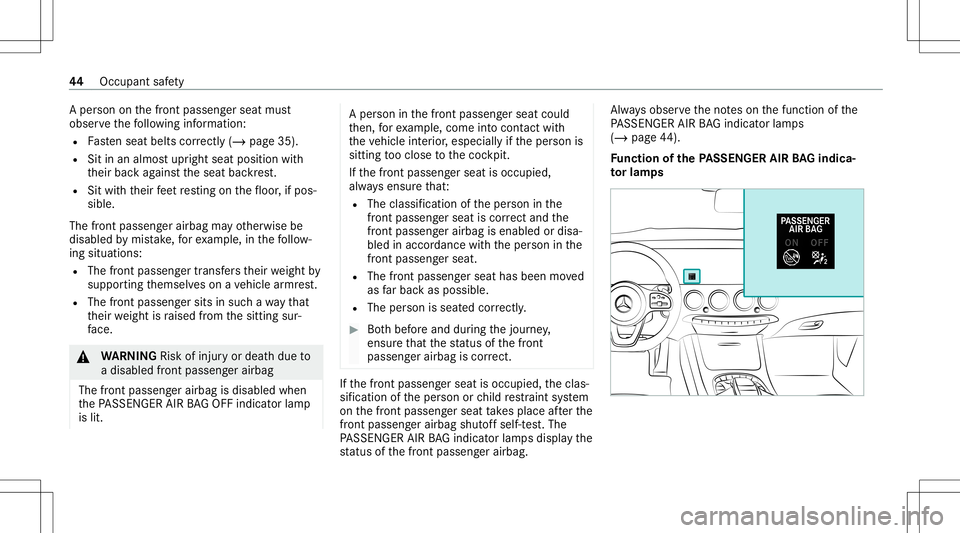
A
pe rson onthefront passeng erseat must
obser vethefo llo wing informatio n:
R Fasten seat belts correctl y(/ page 35).
R Sitinan almos tupr ight seatposi tion with
th eir bac kag ains tth eseat backres t.
R Sitwithth eir feet resting onthefloor ,if pos‐
sible.
The front passeng erairbag mayot her wise be
disabl edbymis take ,fo rex am ple, inthefo llo w‐
ing situat ions:
R The front passen gertr ansf ersth eir weight by
suppor tingthemselv eson ave hicle armr est.
R The front passeng ersits insuc hawa yth at
th eir weight israised from thesitt ing sur‐
fa ce. &
WARNIN GRisk ofinju ryor deat hdue to
a disable dfron tpasse nger airbag
The fron tpasse nger airbag isdisable dwhen
th ePA SSENGER AIRBAGOF Find icat orlam p
is lit. A
per son inthefront passeng erseat could
th en, forex am ple, com eint ocon tact with
th eve hicle interior ,especially ifth eper son is
sitt ing tooclose tothecoc kpit.
If th efront passeng erseat isoccupied,
alw aysensur eth at:
R The classificat ion oftheper son inthe
fr ont passeng ersea tis cor rect and the
fr ont passeng erairb agisenabl edordisa ‐
ble din accor dance withth eper son inthe
fr ont passeng ersea t.
R The front passeng ersea thas been moved
as farbac kas possi ble.
R The person isseat edcor rectl y. #
Both bef oreand during thejour ney,
ensur eth at thest atus ofthefront
passeng erairbag iscor rect. If
th efront passeng erseat isoccupied, theclas‐
sif ication oftheper son orchild restra int system
on thefront passeng erseat take splace afte rth e
fr ont passeng erairb agshut offself-t est.The
PA SSENGER AIRBAGind icat orlam psdispla yth e
st atus ofthefront passeng erairbag. Alw
aysobser vetheno teson thefunc tion ofthe
PA SSENGER AIRBAGind icat orlam ps
(/ page44 ).
Fu nction ofthePA SSEN GERAIRBAGindic a‐
to rlam ps 44
Occupant safety
Page 52 of 510
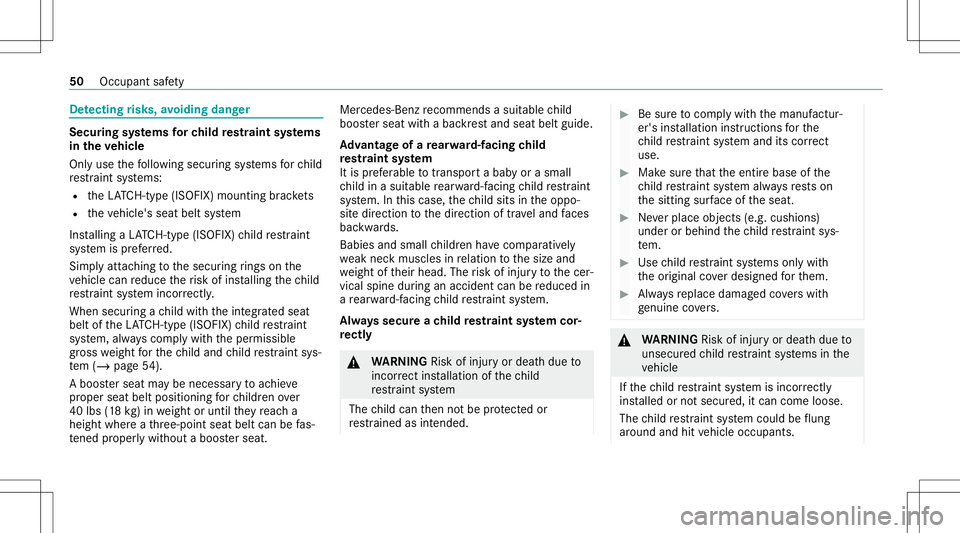
De
tectin grisk s,avo iding danger Secur
ingsystems forch ild restra int systems
in theve hicl e
Only usethefo llo wing secur ingsystems forch ild
re stra int systems:
R theLA TC H-type (ISOFIX )mou nting brac kets
R theve hicle's seatbeltsystem
Ins talling aLA TC H-type (ISOFIX )ch ild restra int
sy stem isprefer red.
Sim plyatt aching tothesecur ingrings onthe
ve hicle canreduce therisk ofins talling thech ild
re stra int system incor rectl y.
When securingach ild withth eint egr ated seat
belt oftheLA TC H-type (ISOFIX )ch ild restra int
sy stem, alwayscom plywithth eper missible
gr oss weight forth ech ild and child restra int sys‐
te m (/ page54 ).
A boos terseat maybe necessar yto achie ve
pr oper seatbeltposition ingforch ildr enove r
40 lbs (18 kg )in we ight orunt ilth ey reac ha
heigh twher eath re e-point seatbeltcanbefas‐
te ned prop erly without aboos terseat. Mer
cedes-Benz recomme ndsasu itab lech ild
boos terseat withabac kres tand seat beltguide.
Ad vantag eof are ar wa rd-faci ng child
re stra int system
It is prefer able totrans portabab yor asmall
ch ild inasuit able rear wa rd-faci ng child restra int
sy stem. Inthis case, thech ild sits intheoppo‐
sit edir ect ion tothedir ect ion oftra veland faces
ba ckwa rds.
Babies andsmall childr enhave com parativ ely
we ak nec kmusc lesinrelation tothesize and
we ight oftheir head. Therisk ofinjur yto thecer‐
vical spine during anacciden tcan bereduced in
a re ar wa rd-faci ng child restra int system.
Alw ayssecur each ild restra int system cor‐
re ctl y &
WARNIN GRisk ofinju ryor deat hdue to
inc orrect ins tallation ofthech ild
re stra int system
The child can then notbe protect edor
re stra ined asintended . #
Besureto com plywith themanuf actur‐
er's installation instruct ions forth e
ch ild restra int system and itscor rect
us e. #
Makesur eth at theent ire base ofthe
ch ild restra int system alwaysre stson
th esitt ing surface oftheseat. #
Neverpla ceobjects (e.g.cushi ons)
under orbehi ndthech ild restra int sys‐
te m. #
Use child restra int systems onlywit h
th eor iginal coverdesi gned forth em. #
Alw aysre place damag edcovers wit h
ge nui ne covers. &
WARNIN GRisk ofinju ryor deat hdue to
uns ecur edchild restra int systems inthe
ve hicle
If th ech ild restra int system isincor rectl y
ins talled ornotsecur ed,itcan com eloose.
The child restra int system could beflung
ar oun dand hitvehicle occupants. 50
Occupant safety
Page 100 of 510
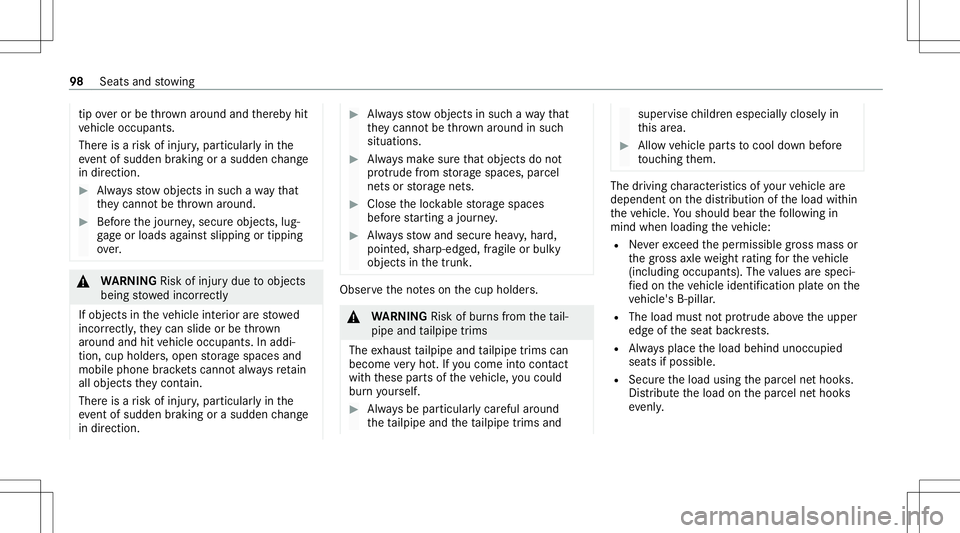
tip
ove ror be throw nar ou nd and ther eb yhit
ve hicle occupants.
Ther eis arisk ofinjur y,par ticular lyin the
ev ent ofsudden braking orasudden chang e
in dir ect ion. #
Alw aysst ow object sin suc hawa yth at
th ey canno tbe thro wn around . #
Beforeth ejour ney,secur eobjects, lug‐
ga ge orloads agains tslipping ortipping
ove r. &
WARNIN GRisk ofinju rydue toobject s
being stowe dincor rectl y
If obje ctsintheve hicle interior arestowe d
inc orrectly ,th ey can slide orbe throw n
ar oun dand hitvehicle occupants. Inaddi‐
tion, cupholder s,open stor ag espaces and
mobile phonebrac kets cann otalw aysre tain
all obje ctsth ey cont ain.
The reisarisk ofinjur y,par ticular lyin the
ev ent ofsudden braking orasudden chang e
in dir ect ion. #
Alw aysst ow object sin suc hawa yth at
th ey canno tbe thro wn around insuc h
sit uation s. #
Alw aysmak esur eth at obj ect sdo not
pr otru de from stor ag espaces, parcel
ne ts or stor ag ene ts. #
Close theloc kable stor ag espaces
bef orest ar tin gajo ur ne y. #
Alw aysst ow and securehea vy,har d,
poin ted, shar p-edg ed,fragile orbulky
objec tsinthetrunk . Obser
vetheno teson thecup holder s. &
WARNIN GRisk ofburnsfrom theta il‐
pipe andtailpipe trims
The exhaus tta ilpipe andtailpipe trims can
becom eve ry hot.Ifyo uco me intoco ntact
wit hth ese partsof theve hicle, youco uld
bur nyo urself . #
Alw aysbe par ticular lycareful arou nd
th eta ilpipe andtheta ilpipe trims and super
visechildr enespec iallycloselyin
th is area. #
Allo wvehicle partsto cool down before
to uc hin gth em. The
driving charact eristic sof your vehicle are
dependent onthedis tribution oftheload within
th eve hicle. Yousho uld bear thefo llo wing in
min dwhen loading theve hicle:
R Neverex ceed theper missible gross mass or
th egr oss axle weight rating forth eve hicle
(including occupants). Thevalues arespec i‐
fi ed on theve hicle identif ication plateon the
ve hicle's B-pillar.
R The load mustno tpr otru de abo vetheupper
edg eof theseat backres ts.
R Alw aysplace theload behind unoccupied
seats ifpossible.
R Secur eth eload using thepar cel nethook s.
Dis tribut eth eload onthepar cel nethook s
eve nly. 98
Seats andstow ing
Page 102 of 510
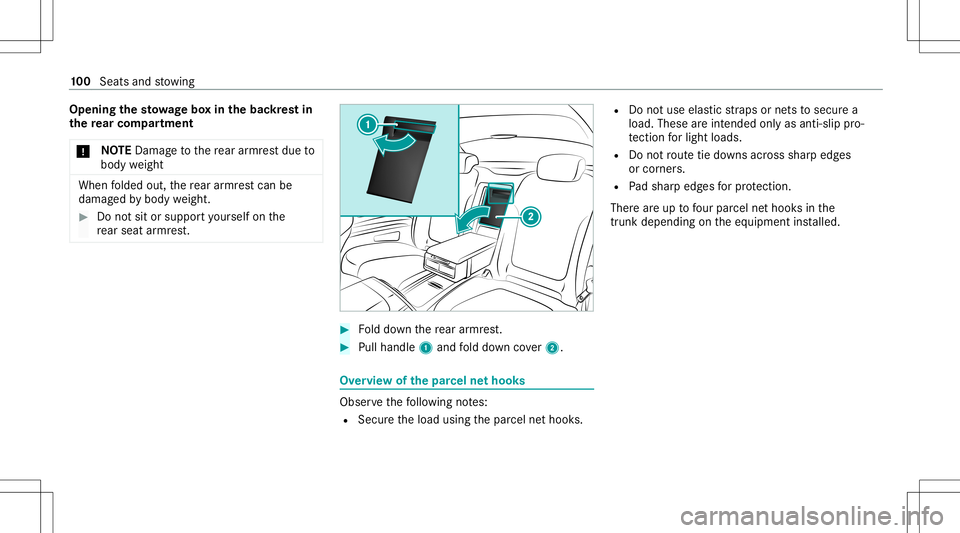
Opening
thesto wage boxin thebac kres tin
th ere ar comp artment
* NO
TEDama getothere ar armr estdue to
body weight When
folded out,there ar armr estcan be
damag edbybody weight . #
Donotsit orsuppor tyo urself onthe
re ar seat armr est. #
Folddo wn there ar armr est. #
Pull handle1and fold do wn cover2. Ov
ervie wof thepa rcel ne thook s Obser
vethefo llo wing notes:
R Secur eth eload using thepar cel nethook s. R
Donotuse elasticstra ps ornets to secur ea
load. These areint ended onlyas anti-slip pro‐
te ction forlig ht loa ds.
R Donotro utetie downs across shar pedg es
or corners.
R Padshar pedg esforpr otect ion.
Ther ear eup tofour par cel nethook sin the
tr unk dependi ng on theeq uipment installed. 10
0
Sea tsand stow ing
Page 359 of 510
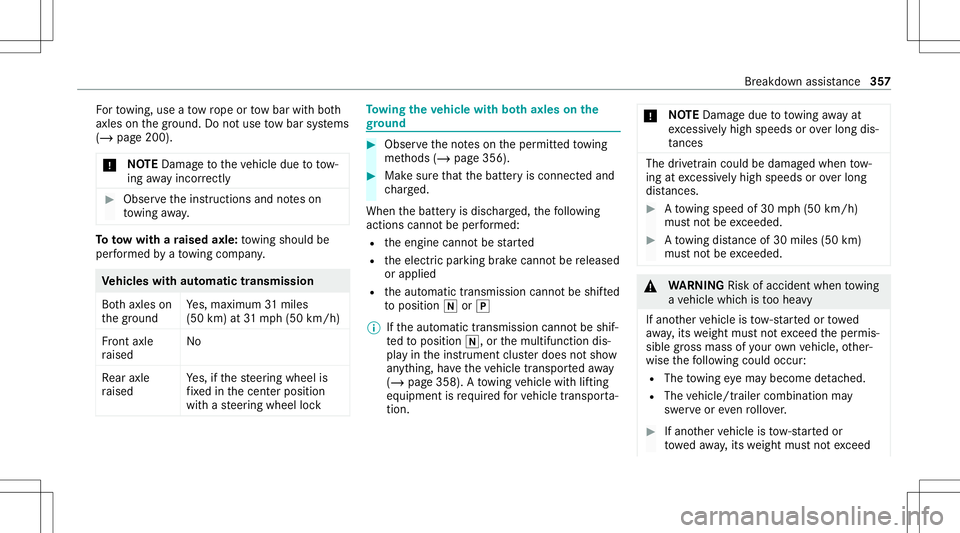
Fo
rto wing, useato w rope ortow bar withbo th
axle son thegr ound. Donotuse tow bar systems
(/ page200).
* NO
TEDama getotheve hicle duetotow‐
ing away inc orrectly #
Obs erve theins truction sand noteson
to wing away. To
tow wit hara ised axle: towing should be
per form ed byato wing company. Ve
hicl eswith automatic transmiss ion
Bo th axle son
th egr ound Ye
s,maximum 31mile s
(50 km) at31 mp h(5 0km/h)
Fr ont axle
ra ised No
Re ar axle
ra ised Ye
s,ifth esteer ing wheel is
fi xe din thecent erposition
wit hast eer ing wheel lock To
wing theve hicl ewith both axle son the
gr ound #
Obser vetheno teson theper mitt edtowing
me thods (/page356). #
Mak esur eth at thebatt eryis con nect edand
ch arge d.
When thebatt eryis disc harged, thefo llo wing
act ions cannotbe per form ed:
R theengine cannotbe star ted
R theelectr icpar king brak ecann otbe released
or applied
R theaut omatic transmiss ioncann otbe shif ted
to position 005Cor005D
% Ifth eaut omatic transmiss ioncann otbe shif‐
te dto position 005C,orthemultifunc tiondis‐
pla yin theins trument clusterdoes notsho w
an ything, have theve hicle transpor tedaw ay
( / pag e358). Atowing vehicle withlifting
eq uipment isrequ ired forve hicle transpor ta‐
tio n. *
NO
TEDama gedue totowing away at
exc essiv elyhigh speeds orove rlong dis‐
ta nces The
drivet ra in could bedamag edwhen tow‐
ing atexc essiv elyhigh speeds orover long
dis tances. #
Atowing speed of30 mph(50 km/h)
mus tno tbe exc eeded. #
Atowing distan ceof30 miles(50 km)
mus tno tbe exc eeded. &
WARNIN GRisk ofacci dent whento wing
a ve hicle whichis toohea vy
If ano ther vehicle istow- star tedor towe d
aw ay,its weight mustno texc eed theper mis‐
sible gross mass ofyour ow nve hicle, other‐
wise thefo llo wing could occur:
R The towing eyema ybecome detach ed.
R The vehicle/tr ailercombination may
sw erve oreve nro llo ver. #
Ifano ther vehicle istow- star tedor
to we daw ay,its weight mustno texc eed Br
eakdo wnassis tance 35
7
Page 360 of 510
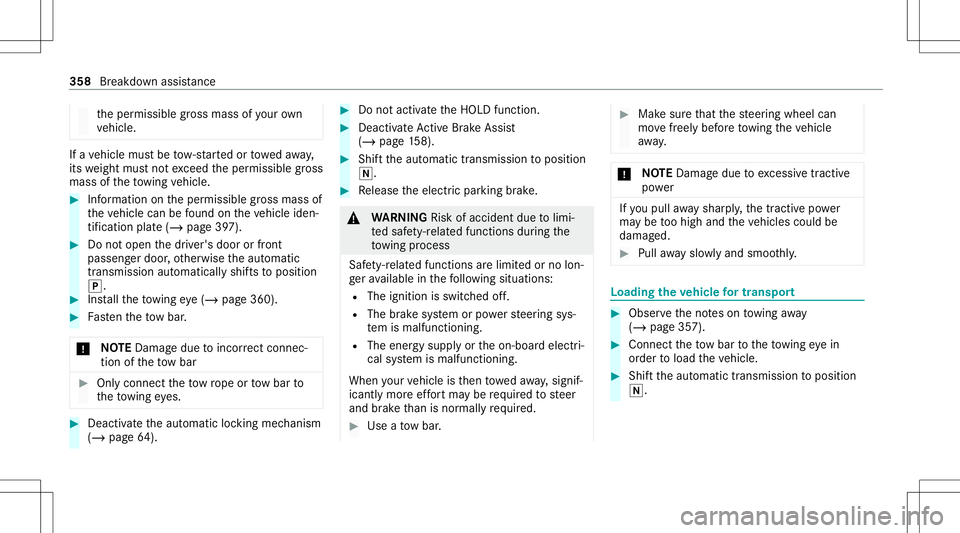
th
eper missible gross mass ofyour ow n
ve hicle. If
ave hicle mustbe tow- star tedor towe daw ay,
its weight mustno texc eed theper missible gross
mass oftheto wing vehicle. #
Information ontheper missible gross mass of
th eve hicle canbefound ontheve hicle iden‐
tif ication plate(/ page39 7). #
Donotopen thedr iver's door orfront
passeng erdoor ,ot her wise theaut omatic
tra nsmiss ionautomaticall yshif tsto position
005D. #
Installth eto wing eye(/ page360). #
Fasten theto w bar .
* NO
TEDama gedue toinc orrect connec‐
tion oftheto w bar #
Onlyconnect theto w rope ortow bar to
th eto wing eyes. #
Deact ivat eth eaut omatic locking mechanism
(/ page64 ). #
Donotactiv ateth eHOLD function. #
Deact ivat eAc tiveBr ak eAssi st
( / pag e15 8). #
Shif tth eaut omatic transmiss iontoposition
005C. #
Release theelectr icpar king brak e. &
WARNIN GRisk ofacci dent dueto limi‐
te dsaf ety-re lat ed func tionsdur ing the
to wing proce ss
Saf ety-re lat ed func tionsar elimit edorno lon‐
ge rav ailable inthefo llo wing situat ions:
R The ignit ionisswitc hedoff.
R The brak esy stem orpowe rst eer ing sys‐
te m ismalfu nctioning.
R The ener gysupp lyor theon- boar delectr i‐
cal system ismalfunct ioning.
When your vehicle isthen towe daw ay,signif ‐
icant lymor eef fort ma ybe requ ired tosteer
and brak eth an isno rm allyre qu ired. #
Use ato w bar . #
Mak esur eth at thesteer ing wheel can
mo vefreely beforeto wing theve hicle
aw ay. *
NO
TEDama gedue toexcess ive tracti ve
po we r If
yo upull away shar ply, thetractiv epo we r
ma ybe toohigh andtheve hicles couldbe
damag ed. #
Pull away slo wlyand smoo thly. Lo
adi ng the vehicl efo rtr ans port #
Obser vetheno teson towing away
( / pag e35 7). #
Connec tth eto w bar totheto wing eyein
or der toload theve hicle. #
Shif tth eaut omatic transmiss iontoposition
005C. 358
Breakdo wnassis tance
Page 374 of 510
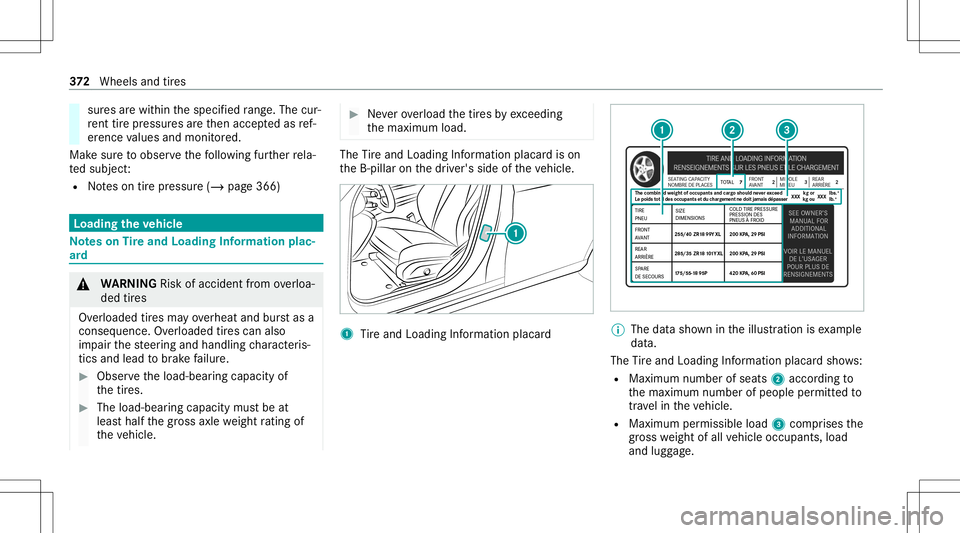
sur
esarewit hin thespecif iedrang e. The cur‐
re nt tirepr ess ures areth en accep tedas ref‐
er ence values andmon itor ed.
Mak esur eto obser vethefo llo wing further rela‐
te dsubjec t:
R Noteson tirepr essur e(/ page366) Loading
theve hicl e No
teson Tire and Loading Information plac‐
ar d &
WARNIN GRisk ofacci dent from overloa‐
ded tires
Ov erloaded tires ma yove rheat and burstas a
con sequenc e.Ov erloaded tires can also
im pair thesteer ing and handling charact eris‐
tic sand lead tobrak efa ilur e. #
Obser vetheload-bear ingcapacity of
th etir es. #
The load-bear ingcapacity mustbe at
leas thalf thegr oss axle weight rating of
th eve hicle. #
Neverove rload thetir es by exc eeding
th emaximum load. The
Tire and Loadi ngInfo rm atio nplacar dis on
th eB-pillar onthedr iver's side oftheve hicle. 1
Tire and Loadi ngInfo rm atio nplacar d %
The datasho wnintheillus tration isexam ple
dat a.
The Tire and Loadi ngInfo rm atio nplacar dsho ws:
R Maximum numberofseats 2accor dingto
th emaximum numberofpeople permitt edto
tr ave lin theve hicle.
R Maximum permissible load3com prises the
gr os swe ight ofall vehicle occupants, load
and luggage. 37
2
Wheels andtires
Page 375 of 510
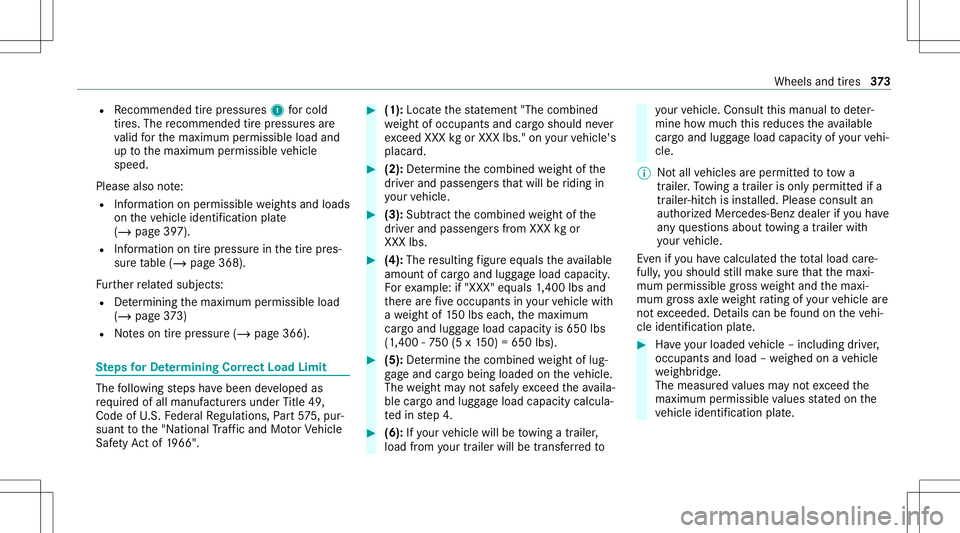
R
Recomme ndedtirepr ess ures 1 forcold
tir es. The recomme ndedtirepr ess ures are
va lid forth emaximum permissible loadand
up tothemaximum permissible vehicle
speed.
Please alsonote:
R Information onper missib lewe ight sand loads
on theve hicle identif ication plate
(/ page39 7).
R Information ontirepr essur ein thetir epr es‐
sur eta ble (/ page368 ).
Fu rther relat ed subje cts:
R Determ inin gth emaximum permissible load
(/ page37 3)
R Noteson tirepr essur e(/ page366). Ste
psforDe term ining Correct Load Limit The
follo wing steps have been developed as
re qu ired ofall manuf acturersunder Title 49,
Co de ofU.S. Feder alRe gulations, Part57 5, pur‐
sua nttothe"N ational Traf fic and MotorVe hicle
Saf etyAc tof 1966". #
(1):Locat eth est at emen t"The combined
we ight ofocc upant sand cargoshould never
exc eed XXX kgorXXX lbs." onyour vehicle's
placar d. #
(2): Determ ine thecombin edweight ofthe
dr iver and passeng ersth at will beriding in
yo ur vehicle. #
(3): Subtr actthecombin edweight ofthe
dr iver and passeng ersfrom XXX kgor
XXX lbs. #
(4): The resulting figur eeq uals theav ailable
amoun tof car goand luggageload capac ity.
Fo rex am ple: if"XXX "eq uals 1,400 lbsand
th er ear efive occupant sin your vehicle with
a we ight of150lbs eac h,themaximum
car goand luggageload capacity is650 lbs
(1 ,400 -75 0(5 x15 0) =650 lbs). #
(5):De term ine thecombin edweight oflug‐
ga ge and cargobein gloaded ontheve hicle.
The weight mayno tsaf elyexc eed theav aila‐
ble cargoand luggageload capac itycalc ula‐
te din step 4. #
(6): Ifyo ur vehicle willbetowing atrailer ,
load from your trailer willbetrans ferred to yo
ur vehicle. Consult this manual todeter‐
mine howmuc hth is reduces theav ailable
car goand luggageload capac ityofyour vehi‐
cle.
% Notall vehicles areper mitt edtotow a
trailer .To wing atrailer isonl yper mittedifa
tra iler -hit chisins talled. Please consult an
aut hor ized Mercedes -Benz dealer ifyo uha ve
an yqu estion sabout towing atrailer with
yo ur vehicle.
Ev en ifyo uha ve cal cul ated thetot alload care‐
full y,yo usho uld still mak esur eth at themaxi‐
mum permissible gross weight andthemaxi‐
mum gross axle weight rating ofyour vehicle are
no texc eeded. Details can befound ontheve hi‐
cle identif ication plate. #
Have your loaded vehicle –including driver ,
occupants andload –we ighed onave hicle
we ighbr idge.
The measur edvalues mayno texc eed the
maximu mper missi blevalues stat ed on the
ve hicle identif ication plate. Wheels
andtires 37
3